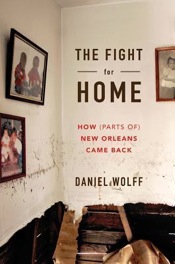Stalking the storyline of my book on New Orleans’ recovery, “The Fight for Home,” was what you might call the fight against home. Even as the people I profiled — Carolyn Parker, Pastor Mel Jones, and many others — struggled to get back into their neighborhoods, there was a growing sense that, as a number of people put it, “They don’t want us back.”
The “they” in this case seemed to be government; the “us” was low-income residents of color; and the reason was simple: there was money to be made from re-configuring New Orleans as a “boutique city” with a “new economy.” From the mayor’s original redevelopment plan — which designated “inner city” neighborhoods as not worth recovering — to the continuing focus on gentrifying the riverfront “crescent,” official New Orleans has used the Katrina disaster as an opportunity for 21st century urban renewal.
You can see it in the Lower Ninth Ward area known as Backatown, where the city made it almost impossible for former residents to rebuild on their properties (many of which are now occupied by post-modern Brad Pitt houses). You can see it in the attempt to pass laws to keep Mardi Gras Indians off the streets of Treme because more recent, more up-scale residents complain that this centuries-old African-American tradition is too noisy.

You can see it in the political battle over what class of business should be allowed to return to Pastor Mel’s Gentilly neighborhood. You can see it in the closing of public schools and the dismissal of long time teachers – many of whom are black – in favor of charter schools with imported Teach for America staffs. Maybe the easiest way to see it is simply to take a drive through New Orleans today and note which neighborhoods seem to have recovered and which haven’t, who lives where, and who doesn’t.
In the case of Carolyn Parker’s Holy Cross neighborhood, you can see it in the current battle over development. This part of the Lower Ninth used to be “anchored” by the private Holy Cross School. The school abandoned its property post-Katrina, even as Carolyn and her neighbors were fighting to get back home. Now, a developer has decided the best plan for the thirteen acres is a massive high-rise and high-price condo project. As one commentator put it, “The Holy Cross plan, promoted by the politically well-connected Perez Architecture firm, calls for 284 residential units, plus commercial uses, 500 parking places and the loss of a stand of live oaks. This is nearly quadruple the current density of an historic neighborhood noted for its small-town feel!”
It’s anchors like this that drown neighborhoods. They price people out of their houses and celebrate a new economy where only the new New Orleans is welcome. That’s why, almost nine years after the floods, people are still fighting as hard as ever. And could still use your support.
Here’s a video showing some Holy Cross neighbors who oppose the condo project — and how the developers have resorted to fake petitions in trying to get their high-rise “renewal” passed.
Daniel Wolff’s “The Fight for Home: How (Parts of) New Orleans Came Back” is out in paperback this month.